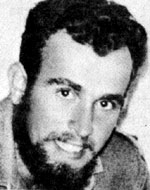Segal, Shlomo (“Shlomik”)
Son of Avraham and Sarah, farmers in Moshav Hagla, one of the first settlers in the moshav. Shlomo, their youngest son, was born on January 22, 1946. He completed his elementary studies in the moshav and attended high school in Hadera, where he enjoyed sports (soccer and basketball) and was a member of HaPoel in Hadera. When he joined the IDF in May 1964, he joined the Golani and found a book about the history of the brigade. He read it until he knew the story of the brigade and the details of the battle. He was proud of the brigade, and he had already noted in his first letters from basic training. He took an officer’s course and served as a mortar officer. After that he was an operations officer. Throughout his apprenticeship, Solomon excelled in all subjects, according to the testimony of his friends, but more than he excelled as an apprentice he stood out as a friend and therefore everyone loved him and appreciated him. He knew the consequences that might come from the adventurous life of an army man and therefore prepared himself to leave the army for a while and go to study at the Hebrew Technion in Haifa so that professional education would not evade him. When his friends broke up with him – it was about a week before the battle for Tel al-Fakhr – he looked up to the war and said: ‘We will go up on the plateau, we will do it even though the price will be expensive, very expensive …’ “At the outbreak of the Six-Day War, He served and served as a company commander with the rank of captain. In the battle at Tel al-Fahr in the Golan Heights while moving towards the target, his job was to lead the tanks, and he traveled at the time in the first tank to the target. After carrying out his duties, he climbed onto a caterpillar and went to look for the battalion commander. Then he was hit: it was on the fifth day of the battles, he was 1 Sivan 5727 (9.6.1967). In Afula, and after a while he was put to rest at the military cemetery in Haifa. The commander of his regiment wrote a letter of condolence to his family, in which he noted that “he was devoted and loyal to the battalion and to the state … He was a symbol and a model to his friends, and he never hesitated and did not hesitate to carry out the difficult tasks he was entrusted with – . In a booklet issued by the Emek Hefer Regional Council in memory of the Emek Hefer members who fell in battle, his memory was commemorated. His name was also immortalized in a booklet published in memory of high school students in Hadera.
